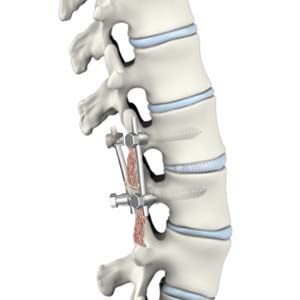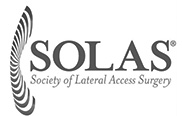Transforaminal Lumbar Interbody Fusion

Transforaminal lumbar interbody fusion (TLIF) is a type of spinal fusion procedure in which bone graft is placed between the affected vertebrae in the lower back (lumbar) region through an incision on the patient’s back.
Indications:
Based on the spinal condition, age, activity levels, and the medical history of the patient, the surgeon may recommend TLIF as a treatment option.
It is indicated in the following spinal instability conditions:
- Degenerative disc disease (damaged disc)
- Spondylolisthesis (slippage of one vertebra on another)
- Spinal stenosis
The common symptoms associated with lumbar spinal instability are pain, numbness, and muscle weakness in the lower back, hips and legs.
Procedure:
The basic steps involved are as follows:
- A small incision is made in the skin on your back over the affected vertebrae.
- Muscles encircling the affected spine are retracted to gain accessibility to the spine.
- Lamina covering the vertebra is removed to view the nerve roots
- Facet joints (structures that connect the vertebrae to one another) may be undercut or trimmed to provide more space for the nerve roots.
- Nerve roots are moved away to remove the disc material from the anterior region of the spine.
- Bone graft is inserted between the vertebrae.
- Screws and rods are fixed to stabilize the spine.
- Soft tissues are re-approximated and the incision is closed.
Recovery:
Most patients who have undergone TLIF surgery go home in one to two days, but in some cases, hospital stay may be extended.
Your surgeon may recommend a few specific post-operative instructions for a fast and better recovery. Generally, patients may return to their routine activities within weeks after surgery.
Risks and complications:
The possible complications associated with TLIF include:
- Infection
- Nerve damage
- Blood clots
- Blood loss
- Bowel or bladder problems
The primary risk of TLIF is failure of fusion of vertebral bone and bone graft which may require an additional surgery.
Please consult your physician for a complete list of indications, warnings, precautions, adverse effects, clinical results and other important medical information that pertains to TLIF procedure.
Related Topics:
- Anterior Cervical Discectomy
- Anterior Lumbar Interbody Fusion
- Cervical Decompression
- Cervical Disc Replacement
- Cervical Foraminotomy
- Cervical Laminectomy
- Cervical Spine Fusion
- Complex Spine Surgery
- Direct Lateral Interbody Fusion
- Oblique Lumbar Inter Body Fusion
- ExcelsiusGPS® Robotic Navigation
- Lumbar Decompression
- Lumbar Discectomy
- Lumbar Fusion
- Lumbar Laminectomy
- Minimally Invasive Spinal Surgery
- Neck Surgery
- Posterior Lumbar Interbody Fusion
- Transforaminal Lumbar Interbody Fusion








